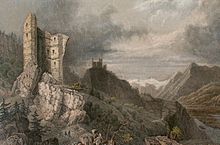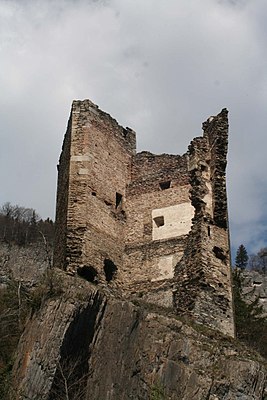Haldenstein Castle
| Haldenstein Castle | ||
|---|---|---|
|
Haldenstein ruins |
||
| Creation time : | around 1100 to 1299 | |
| Castle type : | Höhenburg, rocky location | |
| Conservation status: | ruin | |
| Standing position : | Ministeriale | |
| Construction: | Quarry stone | |
| Place: | Haldenstein | |
| Geographical location | 46 ° 52 '50 " N , 9 ° 31' 24" E | |
| Height: | 630 m | |
|
|
||
The castle Haldenstein was the most important of the three castles on the floor of the community Haldenstein in the Swiss canton of Grisons . The other two castles in Haldenstein are Grottenstein Castle and Lichtenstein Castle .
location
The ruins of the rock castle are on a boulder above the community. Haldenstein can be easily reached in half an hour from the village via a narrow road (no driving). The actual castle can no longer be entered.
investment
Since it was impossible to increase the buildable area, the builders had no choice but to raise the castle if they wanted to gain more space. In fact, several demarcation lines can be seen in the walls, which should come from the various elevations. At the foot of the rock some outbuildings were set up; who were not protected by a bering in the event of a conflict. For a long time, its ruins remained hidden under rock debris until they were exposed by a debris avalanche.
Access was via a ramp at the north foot on the mountain side. On 23/24 December 1769 this path slipped like other parts of the southern section. The gate in the south has disappeared apart from a few traces of the wall; individual wall sections can still be followed due to the foundation bearings carved into the rock.
The five-storey keep , a narrow building with a triangular floor plan, stood on the highest part of the rock. The wall thickness varies between 0.6 meters towards the Palas and 2.2 meters. The dark building was only illuminated by seven narrow slits of light. The high entrance was on the fourth floor, access was from a pillar structure via a wooden gallery that led around the north-west corner on cantilevered wooden beams. It was protected from the weather by a canopy suspended from the wall.
The tower was too narrow to be inhabited. Originally it wore a crenellated crown , later a flat monopitch roof sloping against the mountain was put on it.
The hall was next to the keep. It was originally five stories high and also had a crenellated crown. Later it was raised almost to the height of the keep. Different window shapes come from different living rooms, but their wide openings made them uninhabitable in winter until the introduction of window glass in the 14th century. Several layers can be seen on the interior plaster, which suggests repeated renewal. A staircase next to the tower connected the individual floors. The individual rooms were separated from one another by thin wooden walls. The kitchen was on the first floor.
The water supply probably came from a cistern in the part of the castle that has crashed today.
history

The actual construction time of Haldenstein Castle is unclear. The oldest components go back to the 12th century. The castle was first mentioned in a document in 1299. Due to the technically demanding location on the rock, Haldenstein is probably the youngest of the three Haldenstein castles. From 1260 onwards, the von Haldenstein gentlemen occasionally act as servants for the powerful barons of Vaz . A Berenhardus von Haldenstain is mentioned . The Haldensteiners formed a branch of the von Lichtenstein family, mentioned as early as 1180, who lived in the neighboring Lichtenstein Castle . In 1330 knight Ulrich von Haldenstain (1321–1353) married the heiress of Lichtenstein.
The previous building of the tower was probably in ruins towards the end of the 13th century, which is why Johann von Vaz, probably the owner of the Imperial Bailiwick, wanted to rebuild it. However, the Bishop of Chur , the actual feudal lord of the Haldenstain rulership, did not agree and raised an objection. On March 19, 1299, an arbitration tribunal decided: .... daz dü burg ungebuwen ... should remain - a decision that the client obviously did not adhere to.
The extinction of the Lichtensteiners in the late 13th century and the takeover of their property by the related Haldensteiners led to the formation of the Haldenstein rule around 1300, which was to exist as an independent territory, independent of the Three Leagues , until 1803. A branch line of the Haldensteiners settled on Lichtenstein, while the main line continued to live on Haldenstein. Grottenstein was probably abandoned around 1300.
Trimmis had a knightly branch line from Haldenstain with Heinrich, his son Friedrich, his son Burkhardt and the Ultimus Haldenstain von Haldenstain (died before 1361), all lords of Trimus. The extensive rule of Trimmis with terraced vineyards, mills, Alps, pastures, fields, fields, the Fürsten- and Oldisdwald down to the banks of the Rhine, was in 1361 by Bishop Peter von Kuonitze, called Jelito between Ulrich III and Lichtenstein von Haldenstain for a third on the one hand and Sophia Walther on the other hand, a daughter of Elsine von Haldenstain and Heinz Walther von Feldkirch shared for two thirds, but with the condition that Sophia Walther marry the nephew of Bishop Marcus von Kuonitze.
As a result of a lawsuit brought by the church to the Pope against Bishop Gelito, Bishop Gelito was "promoted" from Chur to Litomysl in Bohemia in 1368 , so that the marriage did not take place and the two-thirds of the allodial rule with Guot and Luot remained illegally in episcopal hands. In 1364, Heinz von Sigberg tried to take over the rule and castle militarily, which failed.
Both Heinz von Sigberg and Haldenstain von Marmels reconciled with the diocese by renouncing all of their rights to the Trimmiser legacy. The rule was then pledged by the Bishop of Chur to various ministerials, initially to Peter von Unterwegen for 20 years. The rule of Trimmus is not listed as episcopal in the catalog of Bishop Flugi from 1645 (p. 37), so it was allodial property of those from Haldentain to Trimus.
Since their appearance in the 13th century, the lords of Haldenstein were at times also ministerials to the barons of Vaz , earlier and later they were in the service of the bishop of Chur, from whom they owned the village and castle as a fief . In 1362 Ulrich von Haldenstein was a mercenary of the Emperor of Austria, and in 1379 he and his two sons again served under the Bishop of Chur. At the end of the 14th century, Ulrich IV, who died in the Habsburg service in 1388 in the battle of Näfels, died out in the male line.
In 1410 Haldenstein was referred to as a fiefdom of the Bishop of Chur, but this apparently could not enforce his rights. There followed inheritance disputes and several changes of ownership. The castle was also pledged several times, without there being any mention of an episcopal fiefdom. Due to the family relationship of the last family members to the von Hohenems family, in 1424 the rule of Haldenstein passed with all sovereign rights to Ursula von Hohenems and her husband Peter von Greifensee, who owned the Habsburgs and Wildegg Castle for a while.
From Peter von Greifensee the rule Haldenstein passed on to his son Rudolf and after him to his sons Hans, Ulrich and Hans Rudolf and to the daughter Ursula. For financial reasons the castle had to be auctioned and so it appeared as the new owner Conrad von Friedingen in 1469 , Heinrich Ammann von Grüningen in 1494 and Conradin von Marmels , Lord von Rhäzüns , one of the most powerful feudal lords of Raetia in the late Middle Ages.
Through the marriage of the widow of his late son Jakob von Marmels, Haldenstein came to the Milanese nobleman Jean Jacques de Castion, the French ambassador to the Three Leagues in Chur. The new owner was probably not completely at ease with Haldenstein's wild romance. He had Haldenstein Castle built in the village from 1544 to 1548 , a representative building without defensive character.
In 1567, the Lord of Neu-Aspermont , Captain Gregor von Hohenbalken, bought Haldenstein from Castion's successors for 3,200 guilders. From 1608 the castle served as a residence for Lord von Hohentrins, Baron Thomas von Schauenstein. According to a letter of protection from the Three Leagues, the rule was transformed into a sovereign dwarf state with judicial power and sovereignty.
In 1612 Thomas von Schauenstein received the right to mint from the emperor , which was used to mint gold and silver coins. Until the von Schauenstein expired around 1695 - after them the Salis-Maienfeld still sat on Haldenstein - the castle was still inhabited, even if it had been neglected in recent decades.
The final turning point came on December 24th, 1769, when the eastern part of the castle rock fell and tore the entrance and hall into the depths. Baron Rudolf von Salis-Haldenstein writes in his chronicle: “... in the excellent cellars they had precious wine. A short time ago you could see whole rooms with good tiled stoves, a nice library, boxes and cases, armor and rifles. In the attic there was a hand mill and a barley mash. The tower had prisons, torture chambers and chambers. The Haldenstein coat of arms was in a paneled room, a black horn in a white field. "
Two years later another section of the wall fell and in an earthquake in 1767 other walls were destroyed. The independence of the Haldenstein lordship expired after several changes of ownership with the union with the canton of Graubünden in 1803.
In July 2014, the ingrown north side was cleared by the municipality's fortress service and in December 2014, on behalf of the Haldenstein Castle Association, security work was carried out on the northern rock section, where the original access to the castle was. A slab of rock threatened to fall into the depths.
gallery
literature
- Fritz Hauswirth: Castles and palaces in Switzerland, Vol. 8: Graubünden. Northern Grisons . Neptun Verlag, Kreuzlingen 1972.
- Otto P. Clavadetscher, Werner Meyer : The castle book of Graubünden . Orell Füssli publishing house, Zurich 1984, ISBN 3-280-01319-4 .
- Werner Meyer: Castles of Switzerland, Vol. 3: Canton of Graubünden . Silva Verlag, Zurich 1983.
- Anton von Castelmur: The castles and palaces of the Canton of Graubünden, Vol. 1: Dominion Prätigau . Birkhäuser-Verlag, Basel 1940.
- Mathis Berger. The state position of the Haldenstein rule in history. Bündner monthly newspaper. 1956 No. 3/4 p. 61-ff
- Lanfranco ABIS de CLARI. Die Friien von Haldenstain und die Haldenstain <Herren zu Trimmis. Genealogy and chronology. Hs in progress 2015.
Web links
Individual evidence
- ↑ Bündner monthly newspaper 1956, issue 3–4.
- ↑ BUB VI 3470 of September 1, 1364, and BAC July 11, 1370 "vmb the attack as sv [those of MARMELS] tatent an der vesti Trÿmus".
- ↑ A. Geigy: Haldenstein and Schauenstein-Reichenau and their coinage: study, presented to the General Assembly of the Members of the General Assembly of the Members of the General Assembly of the Members of Switzerland. Numismatic Society, in Lucerne on September 20, 1888 , Bulletin de la Société suisse de Numismatique, Volume 8, 1889, Issue 8–9
- ↑ Haldenstein ruins on Pro Castellis











